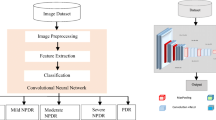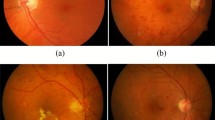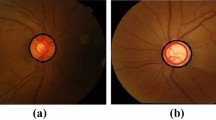Abstract
Purpose
Glaucoma is a chronic and irreversible retinopathy threatening the vision of millions of patients around the world. Its early diagnosis and treatment can help to prolong the period of sight deterioration from no visual impairment to blindness, whereas the screening and diagnosis of glaucoma in clinical remains challenging because some key assessment criteria like cup-to-disc ratio is limited by subjective analysis and intra- and inter-observer variability. This paper exploits the potential of new augmented image data of the optic nerve head (ONH) combining with the latest deep learning networks to achieve better diagnosis of glaucoma.
Methods
This paper explores the potential value of additional three-dimensional topographic map of the optic nerve head proceeded by the latest deep learning approaches, i.e. convolutional neural networks to improve the diagnosis efficiency. Specifically, 3D topography map of the ONH and RGB fundus image has been used to train the transferred AlexNet and VGG-16 networks. The diagnostic performance is compared to those achieved by using the 2D fundus images only.
Results
The 3D topographic map of ONH reconstructed from the shape from shading method provides better visualization of the structure of optic cup and disc. These new enhanced dataset was employed to train the proposed deep learning networks and finally achieve diagnostic accuracy of 94.3% which is superior to the networks trained via 2D conventional images.
Conclusion
Employing the deep learning neural networks with augmented 3D images can increase the accuracy of automatic separating glaucoma and non-glaucoma fundus images. It may be used as an objective tool in developing computer assisted diagnosis systems for assessment of glaucoma.


Similar content being viewed by others
References
Resnikoff S, Pascolini D, Etya’ale D, Kocur I, Pararajasegaram R, Pokharel GP et al (2004) Global data on visual impairment in the year 2002. Bull World Health Organ 82(11):844–851. https://doi.org/10.1590/S0042-96862004001100009
Quigley HA, Broman AT (2006) The number of people with glaucoma worldwide in 2010 and 2020. Br J Ophthalmol 90(3):262–267. https://doi.org/10.1136/bjo.2005.081224
Varma R, Lee PP, Goldberg I, Kotak S (2011) An assessment of the health and economic burdens of glaucoma. Am J Ophthalmol 152:515–522
Roslin M, Sumathi S (2016) Glaucoma screening by the detection of blood vessels and optic cup to disc ratio. In: International conference on communication and signal processing, IEEE, pp 2210–2215. https://doi.org/10.1109/iccsp.2016.7754086
Damms T, Dannheim F (1993) Sensitivity and specificity of optic disc parameters in chronic glaucoma. Invest Ophthalmol Vis Sci 34(7):2246–2250. https://doi.org/10.1111/j.1600-0420.1996.tb00054.x
Morgan JE, Bourtsoukli I, Rajkumar KN et al (2012) The accuracy of the inferior>superior>nasal>temporal neuroretinal rim area rule for diagnosing glaucomatous optic disc damage. Ophthalmology 119(4):723–730. https://doi.org/10.1016/j.ophtha.2011.10.004
Harizman N, Oliveira C, Chiang A et al (2006) The ISNT rule and differentiation of normal from glaucomatous eyes. Arch Ophthalmol 124(11):1579–1583. https://doi.org/10.1001/archopht.124.11.1579
Dave P, Shah J (2015) Applicability of ISNT and IST rules to the retinal nerve fiber layer using spectral domain optical coherence tomography in early glaucoma. Br J Ophthalmol 99(12):1713–1717. https://doi.org/10.1136/bjophthalmol-2014-306331
Chan EW, Liao J, Wong R et al (2013) Diagnostic performance of the ISNT rule for glaucoma based on the heidelberg retinal tomography. Transl Vision Sci Technol 2(5):2. https://doi.org/10.1167/tvst.2.5.2
Dong Y, Zhang Q, Qiao Z, Yang JJ (2017) Classification of cataract fundus image based on deep learning In: IEEE international conference on imaging systems and techniques https://doi.org/10.1109/ist.2017.8261463
Gao X, Lin S, Wong TY (2014) Automatic feature learning to grade nuclear cataracts based on deep learning. In: Asian conference on computer vision. springer, pp 632–642. https://doi.org/10.1007/978-3-319-16808-1_42
Pratt H, Coenen F, Broadbent DM et al (2016) Convolutional neural networks for diabetic retinopathy. Procedia Comput Sci 90:200–205. https://doi.org/10.1016/j.procs.2016.07.014
Choi JY, Yoo TK, Seo JG et al (2017) Multi-categorical deep learning neural network to classify retinal images: a pilot study employing small database. PLoS ONE 12(11):e0187336. https://doi.org/10.1371/journal.pone.0187336
Chen X, Xu Y, Wong DWK et al (2015) Glaucoma detection based on deep convolutional neural network, engineering in medicine & biology society. Conf Proc IEEE Eng Med Biol Soc. https://doi.org/10.1109/embc.2015.7318462
Orlando JI, Prokofyeva E, Fresno MD, et al. (2017) Convolutional neural network transfer for automated glaucoma identification International symposium on medical information processing and analysis https://doi.org/10.1117/12.2255740
Eddine BN, Azizi N, Bouziane SE (2018) Glaucoma diagnosis using cooperative convolutional neural networks. Int J Adv Electro Comput Sci 5(1):31–36
Abbas Q (2017) Glaucoma-deep detection of glaucoma eye disease on retinal fundus images using deep learning. Int J Adv Comput Sci Appl 8(6):41–45
Claro M, Veras R, Santana A et al (2019) An hybrid feature space from texture information and transfer learning for glaucoma classification. J Vis Commun Image Represent. 64:1–19. https://doi.org/10.1016/j.jvcir.2019.102597
Ferreira MVDS, Filho AODC, Sousa ADD et al (2018) Convolutional neural network and texture descriptor-based automatic detection and diagnosis of Glaucoma. Expert Syst Appl 110:250–263. https://doi.org/10.1016/j.eswa.2018.06.010
Cohen J (1960) A coefficient of agreement for nominal scales. Educ Psychol Measur 20(1):37–46. https://doi.org/10.1177/0013164491511008
Carmona EJ, Rincón M, García-Feijoo J, Martínez-de-la-Casa JM (2008) Identification of the optic nerve head with genetic algorithms. Artif Intell Med 43(3):243–259. https://doi.org/10.1016/j.artmed.2008.04.005
Budai A, Bock RR, Maier A, Hornegger J, Michelson G (2013) Robust vessel segmentation in fundus images. Int J Biomed Imaging. https://doi.org/10.1155/2013/154860
Sanchez JL, Sigut J, Gonzalez-Hernandez MA, Alayon S and Fumero F (2011) RIM-ONE: An open retinal image database for optic nerve evaluation 2011 24th International symposium on computer-based medical systems (CBMS) Bristol https://doi.org/10.1109/cbms.2011.5999143
Jayanthi S, Arunava C, Gopal DJ, Tabish AS (2015) A comprehensive retinal image dataset for the assessment of glaucoma from the optic nerve head analysis. JSM Biomed Imaging 2(1):1004
Horn BKP, Brooks MJ (1985) The variational approach to shape from shading. Comput Vis Gr Image Process 32(1):142–175. https://doi.org/10.1016/0734-189x(85)90010-6
Sun, J, Wang, P. (2018) Estimating 3D topographic map of optic nerve head from a single fundus image, In: Ninth international conference on graphic and image processing (ICGIP 2017) https://doi.org/10.1117/12.2302502
Pan SJ, Yang Q (2010) A survey on transfer learning. IEEE Trans Knowl Data Eng 22(10):1345–1359. https://doi.org/10.1109/TKDE.2009.191
Zoph B , Yuret D , May J , et al. (2016) Transfer learning for low-resource neural machine translation
Landis JR, Koch GG (1977) The measurement of observer agreement for categorical data. Biometrics 33(1):159–174. https://doi.org/10.2307/2529310
Funding
This study was funded by Shanghai University of Medicine and Health Sciences (Innovative and Collaborative Project Funding of Shanghai University of Medicine and Health Sciences under grant number SPCI-17–18-001).
Author information
Authors and Affiliations
Contributions
P.P. Wang carried out the experiment and drafted the manuscript with support from all authors. J. Sun conceived the original project and M.Y. Yuan helped to supervise the project.
Corresponding author
Ethics declarations
Conflict of interest
The authors declare that they have no competing interests.
Additional information
Publisher's Note
Springer Nature remains neutral with regard to jurisdictional claims in published maps and institutional affiliations.
Rights and permissions
About this article
Cite this article
Wang, P., Yuan, M., He, Y. et al. 3D augmented fundus images for identifying glaucoma via transferred convolutional neural networks. Int Ophthalmol 41, 2065–2072 (2021). https://doi.org/10.1007/s10792-021-01762-9
Received:
Accepted:
Published:
Issue Date:
DOI: https://doi.org/10.1007/s10792-021-01762-9




